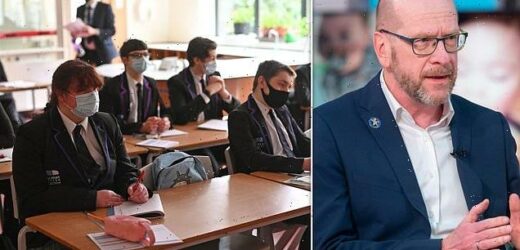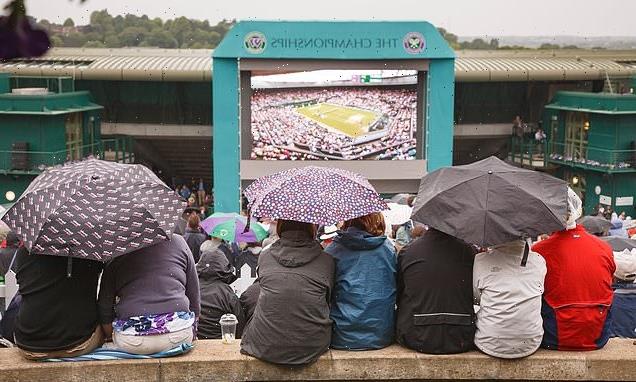SAGE expert urges ministers to rethink school bubble isolation rules before the end of the summer term and insists classrooms are NOT driving the Covid pandemic
- Covid cases are surging in the 10-19 age group and driving current third wave
- If a child in a bubble tests positive, then every other pupil also has to self-isolate
- SAGE’s Professor Russell Viner has now called for a rethink on the bubble policy
Rules on school bubble isolation must be reconsidered before the start of the next academic year, a SAGE expert has urged ministers.
Professor Russell Viner stopped short of calling for bubble arrangements to be scrapped but said a balance should be struck between how much some measures might protect society and how much they might harm children.
He said the government needs to ‘rethink all of our rules about schools’ and said there must be careful thought around putting restrictions on children as the one group in society who are not vaccinated against coronavirus.
Prof Viner also believes that any spare testing capacity should be used on children to try and cut down how much education they miss through isolation.
At the moment, secondary school pupils are asked to take twice weekly lateral flow tests.
Professor Russell Viner stopped short of calling for bubble arrangements to be scrapped but said the government needs to ‘rethink all of our rules about schools’
However, Prof Viner told BBC Radio 4’s Today programme: ‘We set our rules on bubbles quite early in the pandemic and we isolate large numbers of children. I think we need to rethink all of our rules about schools, all of our protections about schools, as we move through into the new school year.’
He added: ‘I absolutely understand the need for certainty in schools, but one of the problems is we have rapidly rising cases and we need some flexibility to be able to react to circumstances.
‘If all adults will be vaccinated – and we won’t get to 100% but we hopefully will get close – and if all adults are vaccinated and can move around freely, we need to think carefully before we put restrictions on the one part of society – our children – who won’t be vaccinated.
‘We need to think carefully about that and we need to look at the evidence.’
Asked if he was talking about getting rid of bubbles for the new academic year, he said: ‘No, not quite. I’m not saying that.
‘I’m saying let’s re-look at all the evidence across all the things we do in school, look at the balance between how much they protect broader society, but how much they harm children.’
Prof Viner also warned that ditching any Covid rules in schools ‘may be a place we get to in the next year, I don’t think it’s a place we will be in September’.
However, he said that schools were ‘not the driver of this pandemic — infections tend to flood into schools from the community.’
According to Government guidance as of May this year, schools must ‘do everything possible to minimise contacts and mixing while delivering a broad and balanced curriculum’.
They are advised to keep groups in bubbles and to maintain distance between individuals, taking into account pupils’ ability to distance, the layout of the building and the feasibility of keeping distinct groups separate while continuing to offer a broad curriculum.
Bubble arrangements are aimed at making it quicker and easier to identify contacts of positive virus cases who might need to self-isolate.
Staggered start and finish times, avoiding large gatherings such as assemblies or collective worship, and keeping distance within classrooms where possible also form part of the guidance.
The current wave that is surging through the UK is being driven by young people who have not been vaccinated.
Rates of infection in the 10-19 age group have more than doubled over the past fortnight and are now 18 times higher than in the over 80s.
According to Government guidance as of May this year, schools must ‘do everything possible to minimise contacts and mixing while delivering a broad and balanced curriculum’
This has led to school bubbles being forced to isolate after someone tests positive.
172,200 pupils were not in school on June 17 and the number is expected to rise.
Secondary school pupils missing school because of Covid also shot up from 1.4 per cent to 4.2 per cent.
The main vaccine-makers have already started, and in some cases published results, from clinical trials on the jabs on children.
Pfizer, Moderna, AstraZeneca and Janssen – the four to have been approved in the UK – are all being tested on under-18s.
In its own clinical trial Pfizer found that the vaccine appeared 100 per cent effective, with no cases of Covid in the vaccinated group, and there were no serious side effects.
Blood tests on the 2,000 children aged 12 to 15 who took part in the trial showed that the jabs appeared to be triggering immunity just as well as they did in adults.
Professor Whitty said that helping schools to stay open could be a big benefit of giving jabs to children.
School-age children and teenagers currently have some of the highest infection rates in the country, and every time a pupil tests positive their whole class is at risk of being sent home to self-isolate.
Public Health England data showed that 10 to 19-year-olds, most of whom are not included in the current vaccine rollout, had the second highest infection rate in the country in the first week of this month, with 99 cases per 100,000 people. This was behind only 121 per 100,000 among people in their 20s.
It comes after a shock report revealed that almost 100,000 pupils have become the ‘lost children of lockdown’ after the pandemic ravaged the education system.
A leading think-tank has uncovered the huge number of youngsters who have failed to return to education full-time after schools reopened their doors.
Analysis of official figures by the Centre for Social Justice (CSJ) has identified 93,514 pupils who were mostly absent between September and December – more than the capacity of Wembley stadium.
The figure for those off school more often than they were present has rocketed by more than 50 per cent on the previous year, with a particularly ‘alarming’ rise in primary schools, as the chaos caused by Covid made it easy for vulnerable youngsters to slip through the net.
It is feared many will end up being expelled or simply drop out of education altogether after the disruption of the past year, putting them at risk of being drawn into a life of crime.
And today’s study says the £3 billion announced by the Government in post-Covid funding will not help those who are no longer in school, pointing out that ‘kids can’t catch up if they don’t show up’.
CSJ chief executive Andy Cook said: ‘When a child disappears from our school system, their future often disappears with them.
‘Our research shows that by the end of last year almost 100,000 pupils were missing more than half of lessons, even after Covid absence is stripped out.
‘These are the lost children of lockdown. Charities working with these children are telling us there’s now a real risk of children being picked up by street gangs.’
Source: Read Full Article




